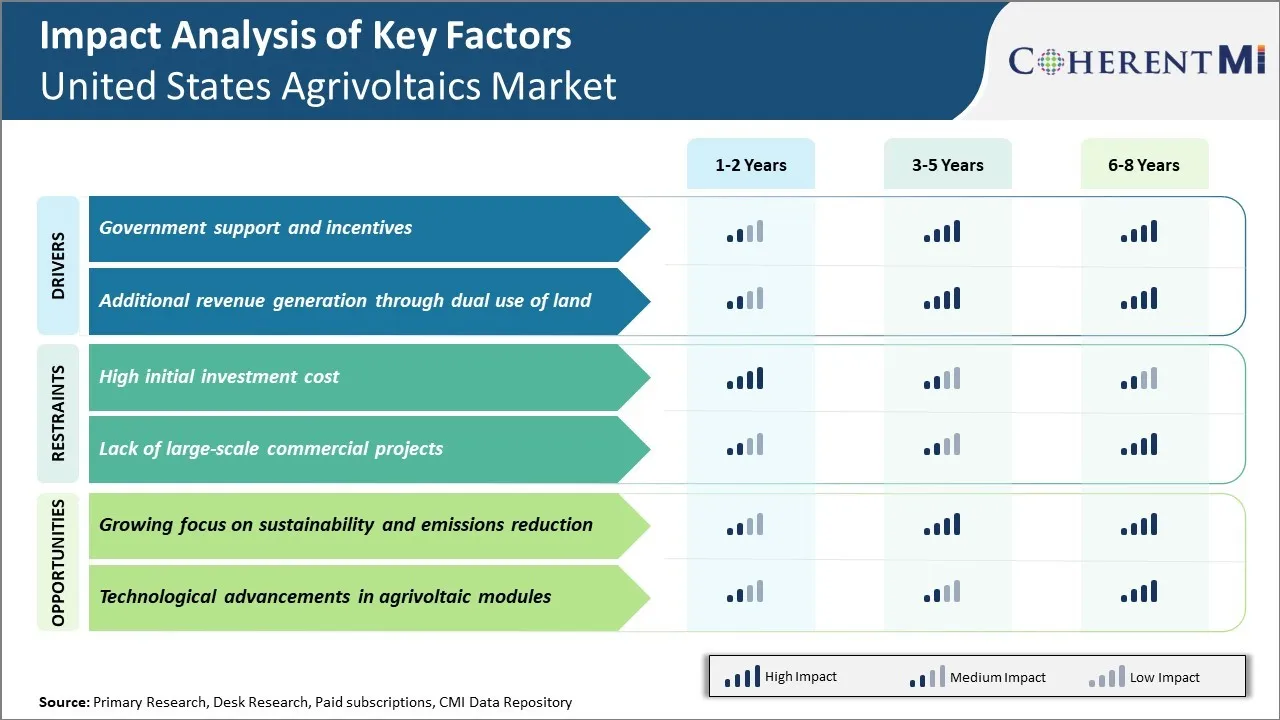United States Agrivoltaics Market Trends
Market Driver - Government Support and Incentives
The Agrivoltaics market in the US is witnessing a strong push from the federal and state governments in terms of various support schemes and incentives. Governments across different states have recognized the potential of Agrivoltaic systems to promote renewable energy generation as well as boost agricultural production. Several states like California, Vermont, Massachusetts, etc. have rolled out various subsidy programs for farmers looking to install Agrivoltaic infrastructure on their land. These subsidy programs cover 30-40% of the total project cost, making Agrivoltaics systems a very viable option for farmers.
Another important development has been the inclusion of Agrivoltaic projects in various renewable energy mandates and targets set by states. Many states offer long term power purchase agreements and higher compensation for each unit of solar power generated through Agrivoltaics systems. This helps in better project returns. Some northeastern states offer additional incentives if the electricity generated is used to fulfill on-site agricultural needs such as for operating milking machinery, heating greenhouses, etc. The federal government too has recognized Agrivoltaics under various programs such as REAP (Rural Energy for America Program) which provides grants and loan guarantees for renewable energy and energy efficiency projects in rural areas.
A positive push has also come from the Farm Bill passed in different years. The recent 2018 Farm Bill promoted Agrivoltaics explicitly under several programs related to conservation of farmlands, diversification of farm operations and promotion of new technologies. This has stimulated a lot of research & development activity into improving Agrivoltaic designs, components and their integration with different crops and agricultural practices. Many agricultural universities and research institutes across premier farming states have also started projects to quantify benefits of Agrivoltaics. They are guiding farmers on suitable crops, optimal designs and business models.
Overall, the supportive policy environment both at federal and key state levels is facilitating significant interest among farmers in the US to install Agrivoltaics on their lands. It allows them to generate additional revenue through solar power sales while still actively farming the same land area. With ongoing technology advancement and more quantified results on higher agricultural productivity and financial gains, the driver of government support and subsidies is expected to keep boosting the Agrivoltaics market size in the coming years.
Market Driver - Additional Revenue Generation through Dual Use of Land
One of the prominent drivers for the growing adoption of Agrivoltaics systems by farmers is the potential to generate additional revenue streams compared to conventional agricultural or solar projects. Unlike standalone solar farms which occupy vast tracts of agricultural lands, Agrivoltaic platforms allow dual use of the same piece of land for both power generation as well as crop cultivation. This opens up new avenues to boost farm revenues.
Through diverse models such as integrating solar panels mounted on structures above crop fields or livestock grazing areas, Agrivoltaics maximize land usage unlike solar farms. Farmers can continue growing high-value crops under and around the solar panels which are elevated to provide sufficient sunlight. Some common crop options being tested are berries, nuts, grapes which generate higher margins compared to traditional row crops. This dual purpose enables farmers to sign long term power purchase deals for solar energy production as well as focus on premium quality crops that fetch attractive prices in the market.
Another emerging opportunity is utilizing unused or low productivity lands within farm premises for deploying Agrivoltaic plants and then leasing out these facilities to solar developers and power producers. This serves as a new stream of rental income over the 25–30-year life of such projects. Some agricultural universities are also pioneering Agrivoltaic powered aquaculture and greenhouse farming which tremendously boosts per acre crop or fish yields.

Data for Market Concentration Infographic
Market Challenges: High Initial Investment Costs
One of the major challenges facing the growth of the United States agrivoltaic market is the high initial investment costs associated with setting up agrivoltaic systems. Agrivoltaic projects require substantial capital expenditure towards purchasing and installing solar panels, mounting structure, inverters, cables, and other auxiliary equipment. Since agrivoltaics is a relatively new concept in the country, the specialized equipment and engineering required for dual-use of land for agriculture and solar also contributes to increased costs. Further, the return on investment may take longer compared to conventional agricultural or solar projects. The high upfront costs deter many farmers and landowners from adopting agrivoltaic solutions and preference traditional modes that require lower capital expenditure. Financial incentives and subsidies from federal and state governments have helped reduce costs to some extent but have limited impact in driving mass adoption. The high capital intensity continues to be a major financial barrier for the widespread growth of the United States agrivoltaic market.
Market Opportunities: Growing Focus on Sustainability and Emissions Reduction
One of the key opportunities for the United States agrivoltaic market is the increasing focus on sustainability and reducing greenhouse gas emissions from various industries including agriculture. There is a rising consumer demand for sustainably produced food and energy which works in favor of the agrivoltaic market. Further, industries and governments are exploring renewable and clean energy solutions to achieve their decarbonization targets. Agrivoltaic systems help boost solar energy production while maintaining agricultural activities underneath. This dual benefit aligns well with the sustainability agenda of minimizing land usage for increased food and energy output. The growing policy push for sustainability also increases the incentive and financial support for agrivoltaic projects. The emphasis on lowering emissions through innovative clean technologies presents significant prospects for the development of the United States agrivoltaic market in the coming years.